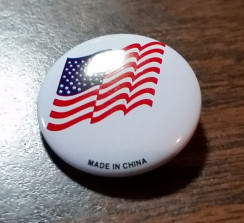The Issue
In 2015, Representative Barbara Comstock stated: “…Decisions of this magnitude should not be issued by FCC 3-2 rulings, rather Congress should debate and make the people’s voice heard on such a critical issue like net neutrality.†(Comstock on Net Neutrality Ruling, February 26, 2015).
My Question
A few days ago, I sent an email to Representative Comstock asking if, given the recent FCC 3-2 ruling to abolish net neutrality, she still believed that “… Congress should debate and make the people’s voice heard on such a critical issue….”
Her answer
Thank you for contacting me to express your concerns regarding the governance of the internet. This topic is sometimes referred to as net neutrality or an open internet. I appreciate hearing from you on this important issue.
First, let me assure you that I am committed to ensuring that the Internet is a level playing field, where competition ensures that consumers benefit from continued innovation and where all companies are held to the same high standards of consumer protection.
As a point Thank you for contacting me to express your concerns regarding the governance of the internet. This topic is sometimes referred to as net neutrality or an open internet. I appreciate hearing from you on this important issue.
First, let me assure you that I am committed to ensuring that the Internet is a level playing field, where competition ensures that consumers benefit from continued innovation and where all companies are held to the same high standards of consumer protection.
As a point of reference, until 2015, the Internet was regulated with a “light touch†framework under Title I of the Communications Act. In fact, during the Clinton Administration, there was a bipartisan, intentional decision to reject heavy-handed regulation as part of the Telecommunications Act of 1996. As a complement to such regulation, the Federal Trade Commission was the “cop on the beat†to address any anti-competitive and anti-consumer behavior.
By all accounts, this “light touch†has been highly successful, with the private sector investing over $1.5 trillion to build out wired and wireless networks throughout the United States. This unprecedented explosion of innovation and investment in technology in the United States includes the establishment and growth of many companies with some of the largest valuations of private corporations in history.
In 2015, the then-Chairman of the Federal Communications Commission (FCC) decided to apply a regulatory structure designed for a 1930s, monopoly wired telephone network, by reclassifying broadband providers under Title II of the Communications Act. This is a heavy-handed regulatory framework that was crafted in the Roosevelt Administration. Economic experts have found that the imposition of this regulatory regime has chilled investment in Internet infrastructure. In fact, broadband network investment declined by $3.6 billion since 2015. Most worrisome, our rural and low-income areas, that most need access to the Internet to thrive, have been hard hit by this reduction in investment.
On December 14th, 2017, the FCC voted 3-2 to return to the regulatory framework of the Internet prior to 2015. This was not an act of Congress. This order also requires Internet Service Providers to inform consumers about their net neutrality policies. I am committed to engaging in a debate in Congress about which policies should be enacted to ensure the consumers are protected, the growth of infrastructure continues, and the Internet continues to be a thriving engine of innovation.
Despite the media furor, Title II and net neutrality are not one and the same. The proposal before the FCC simply returns the internet to the 2015 status—when there were few reports of data throttling or other anti-consumer behaviors. The Internet has always thrived on innovation, not government control. Under Chairman Pai’s plan, the FCC will retain an oversight role and require transparency to all consumers related to prioritization traffic, data caps, and other concerns. The FTC can challenge anti-competitive behavior on a case by case basis, which is better suited to a fast changing, nimble, and cutting-edge industry.
I believe the “light touch†regulatory regime will promote additional investment in broadband. The private sector has proved far better than the government at developing choices and lowering prices for consumers. I want to spur investment and access to broadband services in rural and low-income areas to allow more constituents and small businesses access to the internet.
Thank you again for contacting me. It is a privilege to serve you in the Tenth District. I may also be contacted at my Sterling office at 703-404-6903, or my Washington, D.C. office at 202-225-5136. By visiting http://comstock.house.gov, you can sign up to receive my email newsletters and follow my efforts to serve you. If I may ever be of service, please do not hesitate to contact me.
Sincerely,
Barbara Comstock
Member of Congress
My Conclusion
It was nice of Representative Comstock and her staff to provide a short history of the Internet and the pros and cons of Net Neutrality, with emphasis on the cons. But unless I’ve missed something here, I don’t think my question was ever answered. Or maybe it was! Once again three (3) appointed government officials decided the fate of this critical issue rather than those who represent the people.
 In the wee hours of this morning, Congress passed its latest Funding Bill, which will keep the US Government in business a bit longer. POTUS45 signed the bill and once more took to Twitter to give us his thoughts on the proceedings:
In the wee hours of this morning, Congress passed its latest Funding Bill, which will keep the US Government in business a bit longer. POTUS45 signed the bill and once more took to Twitter to give us his thoughts on the proceedings: